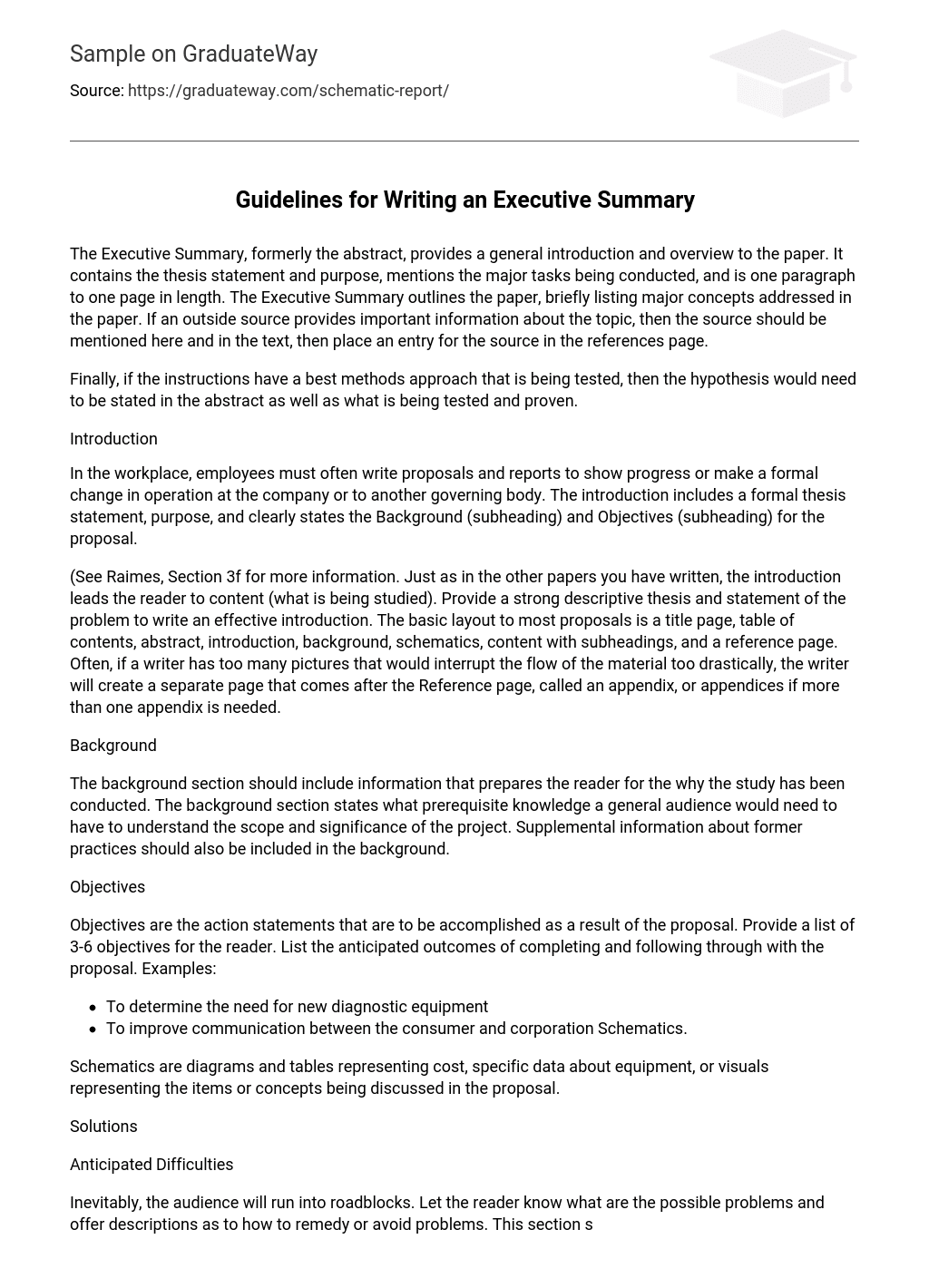The Executive Summary, formerly the abstract, provides a general introduction and overview to the paper. It contains the thesis statement and purpose, mentions the major tasks being conducted, and is one paragraph to one page in length. The Executive Summary outlines the paper, briefly listing major concepts addressed in the paper. If an outside source provides important information about the topic, then the source should be mentioned here and in the text, then place an entry for the source in the references page.
Finally, if the instructions have a best methods approach that is being tested, then the hypothesis would need to be stated in the abstract as well as what is being tested and proven.
Introduction
In the workplace, employees must often write proposals and reports to show progress or make a formal change in operation at the company or to another governing body. The introduction includes a formal thesis statement, purpose, and clearly states the Background (subheading) and Objectives (subheading) for the proposal.
(See Raimes, Section 3f for more information. Just as in the other papers you have written, the introduction leads the reader to content (what is being studied). Provide a strong descriptive thesis and statement of the problem to write an effective introduction. The basic layout to most proposals is a title page, table of contents, abstract, introduction, background, schematics, content with subheadings, and a reference page. Often, if a writer has too many pictures that would interrupt the flow of the material too drastically, the writer will create a separate page that comes after the Reference page, called an appendix, or appendices if more than one appendix is needed.
Background
The background section should include information that prepares the reader for the why the study has been conducted. The background section states what prerequisite knowledge a general audience would need to have to understand the scope and significance of the project. Supplemental information about former practices should also be included in the background.
Objectives
Objectives are the action statements that are to be accomplished as a result of the proposal. Provide a list of 3-6 objectives for the reader. List the anticipated outcomes of completing and following through with the proposal. Examples:
- To determine the need for new diagnostic equipment
- To improve communication between the consumer and corporation Schematics.
Schematics are diagrams and tables representing cost, specific data about equipment, or visuals representing the items or concepts being discussed in the proposal.
Solutions
Anticipated Difficulties
Inevitably, the audience will run into roadblocks. Let the reader know what are the possible problems and offer descriptions as to how to remedy or avoid problems. This section should be at least two paragraphs long. Evidence Provide the reader with the results of the investigation. Represent the findings and write about the information presented in the tables. This section should be at least 4 paragraphs long and should include at least two preferably 3 or 4 pieces of evidence in favor of your findings. Also, the opposition should be addressed in this section Recommendations. The solutions to the problems and benefits of those recommendations need to be Offer the reader solutions to the problem. Separate new recommendations in new paragraphs and develop the ideas thoroughly.
Discussion
The discussion provides a summary of the major points from the paper and can be likened to the conclusion (Raimes, Section 3f). This section should be at least one paragraph long and should bring the paper to a close. The conclusion should also refer to other exemplary manuals, articles or how to contact a person who would be knowledgeable about the topic to learn more about the topic. References See the APA tab in Raimes to cite sources for quotes, paraphrased sentences, summary and pictures in the References page.
Appendix A
The Appendix is used to include in-depth definitions or diagrams that infer with the flow of the reading. Surveys, interviews, price lists, parts lists, and any other lengthy content may be placed in the appendices. If you have more than one picture to place in the Appendix, then add an additional page, label the first appendix. Appendix A, and pace a second, third or fourth appendix in the document, labeling them Appendix B, Appendix C and Appendix D. The picture should be described and labeled appropriately. Label Appendices by letter and place a reference to the appendices in the Table of Contents.





